Native Texas Flowers (With Pictures) – Identification Guide
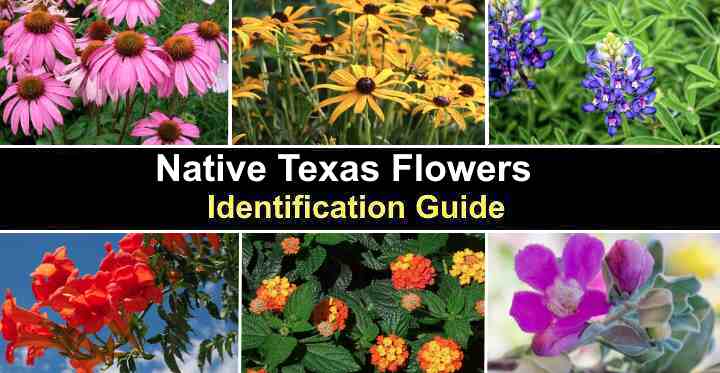
Do you want to enhance the natural beauty of your southern garden landscape? In that case, planting native Texas flowers is the ideal solution. Plants native to the Lone Star State are perfect for any Texan homeowner. The colorful flowers are well-suited to the Texas climate and soil conditions, making them a great addition to any landscape.
Texas boasts a diverse range of stunning wildflowers, such as the iconic bluebonnet and the lesser-known winecup. Because the flowers on this list are native to Texas, they are low-maintenance, complement the state’s ecosystems, and contribute to biodiversity. So, whether you want to add a pop of color to your garden or attract pollinators, there are plenty of native Texas flowers to choose from.
This article is an identification guide to native Texas flowers. Descriptions and pictures of the most common and beautiful wildflowers found in Texas will help you recognize and appreciate the state’s natural flora. You will also get great ideas for planting heat and drought-tolerant plants that will withstand Texas’s harsh, unforgiving climate.
Native Texas Flowers — Identification Guide With Pictures
Let’s look in more detail at some of the iconic native Texas flowers that thrive in most regions, from El Paso in the West to Dallas in the East and as far north as Amarillo or south to Corpus Christi.
Texas Bluebonnet (Lupinus texensis)
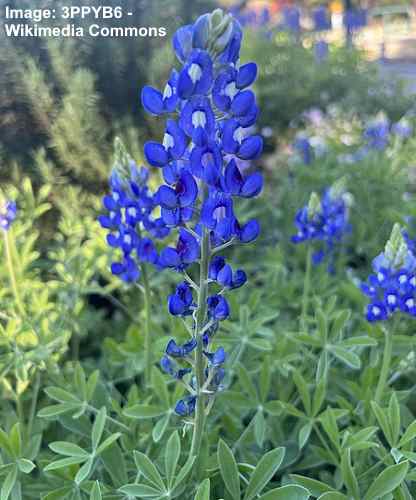
Texas bluebonnet is a native full sun wildflower with purple-bluish flowers
Texas bluebonnet is a native Texas wildflower with spikes of blue-purple flowers that bloom in the spring. The indigo-blue, pea-like flowers grow in dense, cylindrical clusters with a white tip, giving them a unique appearance. The vibrant flowers attract butterflies and bees, adding to biodiversity in your front or backyard.
Texas Bluebonnet is ideal for planting in flower borders and rock gardens or to add spring color and texture to a fence line or foundation planting. The blue flowers also add charm to cottage gardens or native plant gardens in southern landscapes.
The pride of the Lone Star State, the iconic Texas Bluebonnet is the state flower of Texas and a stunning wildflower that grows throughout the south.
USDA Zone: 4 to 8
Sun exposure: Full sun
Soil type: Drought-tolerant and requires well-drained soils
Height: 1 to 2 ft. (0.3 – 0.6 m)
Texas Indian Paintbrush (Castilleja indivisa)
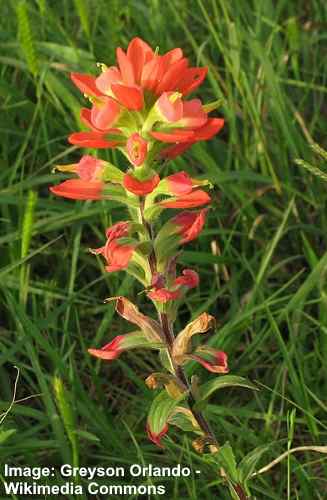
Texas Indian paintbrush is a red flowering native plant that looks best growing in mass plantings
Texas Indian paintbrush is a drought-tolerant native flower that thrives in gardens throughout Texas. Thriving in sunny, southern landscapes, the plant produces bright red or orange flowers that bloom in spring. The colorful clusters of petal-like bracts blooms resemble paintbrushes, giving the plant its name.
Texas Indian paintbrush looks spectacular planted alongside Texas bluebonnets. This wildflower can be found in open fields, meadows, prairies, and along roadsides throughout Texas. The reddish flowers look stunning in flower borders or wildflower gardens. The red and orange flowers are also ideal for adding color accents to spring gardens.
USDA Zone: 6 to 11
Sun exposure: Full sun to partial shade
Soil type: Sandy, loamy, and clay soils, as long as they are not excessively wet or waterlogged
Height: 1 to 2 ft. (0.30 – 0.6 m)
Texas Blazing Star (Liatris punctata var. mucronata)
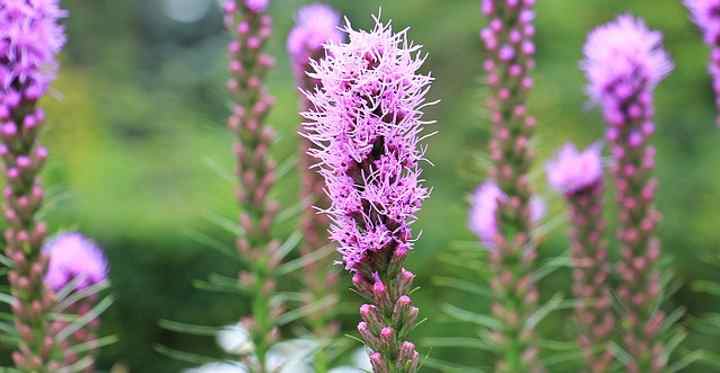
Texas blazing star is a great flower when it comes to attracting pollinators to your garden
Texas blazing star, also known as gayfeather, is a perennial flower native to Texas and the southern United States. The ornamental features of this plant are its tall spikes of vibrant purple flowers and grassy foliage. The eye-catching purple blooms appear in late summer and early fall.
Texas blazing star is a stunning floral addition to any sunny Texas landscape. The native Texas plant is low-maintenance and tolerant to heat and drought. These factors make it ideal for xeriscaping, desert gardens, sunny borders, and rock gardens. Its tall purple flowers add a stunning vertical accent to perennial borders.
USDA Zone: 6 to 9
Sun exposure: Full sun
Soil type: Sandy, gravely, dry soils that drain well
Height: 1 to 3 ft. (0.3 – 1 m)
Texas Rock Rose (Pavonia lasiopetala)
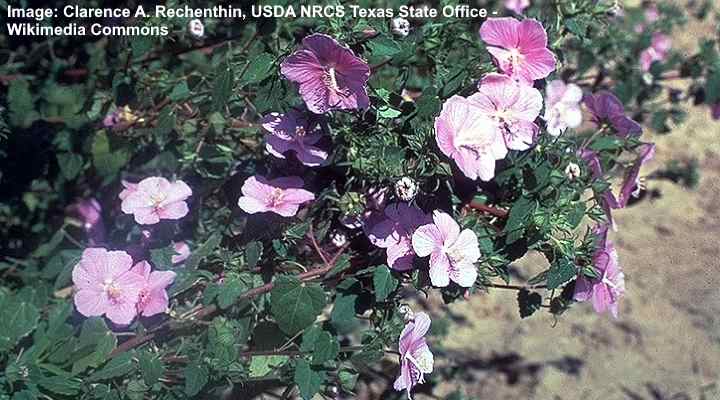
The pink flowering Texas rock rose shrub thrives in dry and sunny conditions
Texas rock rose is a beautiful flowering shrub native to Texas and southern states. The ornamental plant has pink or magenta blooms that appear in the summer and fall. This native shrub’s flowers are hibiscus-like blooms that withstand intense heat and drought. The stunning flowers grow 2” (5 cm) in diameter and have five petals forming a cup shape.
Growing as far north as Lubbock, Texas rock rose is a great addition to any garden. The plant is drought-tolerant and resistant to deer and rabbits, making it a great choice for rural Texas gardens. Texas rock rose looks great in borders, mixed flower beds, as a foundation plant, or in a rock garden.
USDA Zone: 7 to 11
Sun exposure: Full sun or light shade
Soil type: Well-draining, dry soil
Height: 2 to 4 ft. (0.6 – 1.2 m)
Texas Lantana (Lantana urticoides)
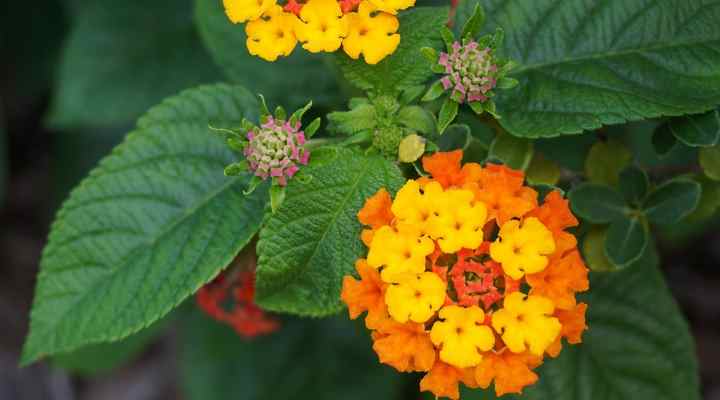
The colorful lantana flowers grow well in the warm areas of Texas and southern USA
Texas lantana is a heat-tolerant and drought-resistant flowering shrub native to Texas, Arizona, and New Mexico. The mounding shrub has broadly ovate leaves and produces clusters of vibrant flowers that bloom throughout the summer and fall. The dainty funnel-like flowers come in shades of yellow, orange, red, and pink. Its resilience to heat, salt, drought, and heat makes the flower a popular choice for Texas gardens.
Texas lantana is a versatile plant that can be used as a ground cover, in flower borders, or as a container plant. The plant is also ideal for xeriscaping, rock gardens, and water-wise landscapes. Suitable for hot and dry climates, Texas lantana is a perfect addition to any landscape in the deep south.
USDA Zone: 8 to 11
Sun exposure: Full sun
Soil type: Well-drained, dry, poor soils
Height: 2 to 3 ft. (0.6 – 1 m)
Texas Mountain Laurel (Sophora secundiflora)
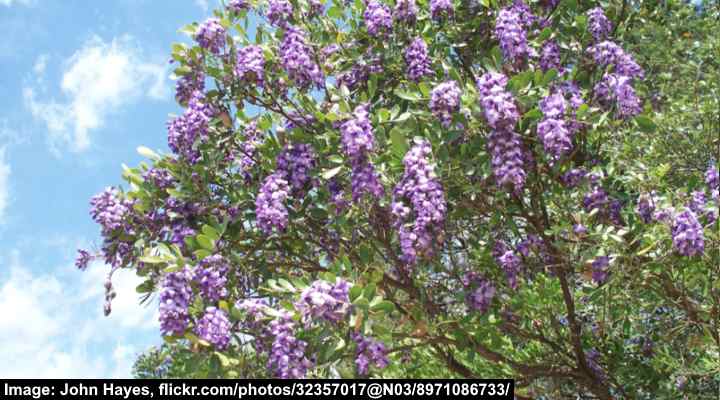
The Texas mountain laurel is a purple flowering tree native to Texas that is suitable for full sun or partial shade
Texas mountain laurel is a fragrant, evergreen shrub or small flowering tree native to Texas and New Mexico. The plant produces clusters of beautiful, wisteria-like purple flowers in the spring. These stunning purple or lavender blooms are fragrant and dangle gracefully from branches. The blooms are followed by pale gray, fuzzy seed pods containing red seeds.
Texas Mountain Laurel is a popular ornamental plant in Texas landscapes. It is ideal for planting in shrub borders, along a foundation line, as a specimen plant, or as an evergreen hedge. The fragrant flowers attract pollinators such as bees and butterflies, making it a great addition to a wildlife garden.
USDA Zone: 7 to 10
Sun exposure: Full sun to partial shade
Soil type: Well-drained soil, tolerant of sandy or rocky soils
Height: 15 to 25 ft. (4.5 – 7.5 m)
Texas Sage (Leucophyllum frutescens)
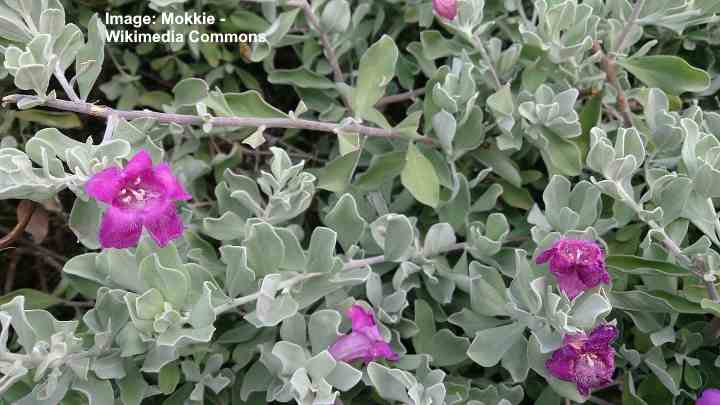
Texas ranger is a low maintenance flowering evergreen shrub with silvery foliage that is drought and heat tolerant
Texas sage—barometer bush or purple sage—is a drought-tolerant flowering evergreen shrub native to Texas. The attractive shrub is known for its fragrant, silvery-gray leaves and a profusion of purple or pink flowers that bloom from summer to fall. The flowers are a magnet for bees and butterflies, making Texas sage a great choice for pollinator gardens.
Texas sage is a low-maintenance plant that can tolerate high heat and drought. It is ideal for xeriscaping, rock gardens, and as an accent plant in borders. The plant’s silvery-gray foliage performs well as a privacy screen or security hedge, adding a unique texture to any landscape design.
USDA Zone: 7 to 11
Sun exposure: Full sun
Soil type: Well-drained, medium moisture soils
Height: 3 to 8 ft. (0.9 – 2.4 m)
Texas Milkweed (Asclepias texana)

Texas milkweed is a native flowering perennial with white flower clusters
Texas milkweed is a native perennial plant producing clusters of bright white flowers throughout summer. The flowers are followed by long, narrow seed pods. These contain seeds with silky, white hairs, which are easily dispersed by the wind.
Texas milkweed is a must-have plant for any butterfly garden or wildlife habitat. The shrubby plant tolerates drought and heat exceptionally well. It’s an excellent addition to wildflower gardens, mixed borders, and naturalistic landscapes.
It’s good to note that milkweeds contain toxic, irritating sap. Therefore, it’s not advisable to plant the shrub where children or pets play in yards.
USDA Zone: 8 to 12
Sun exposure: Full sun to partial shade
Soil type: Well-drained, sandy, or gravelly soils
Height: 1 to 2 ft. (0.3 – 0.6 m)
Trumpet Creeper (Campsis radicans)
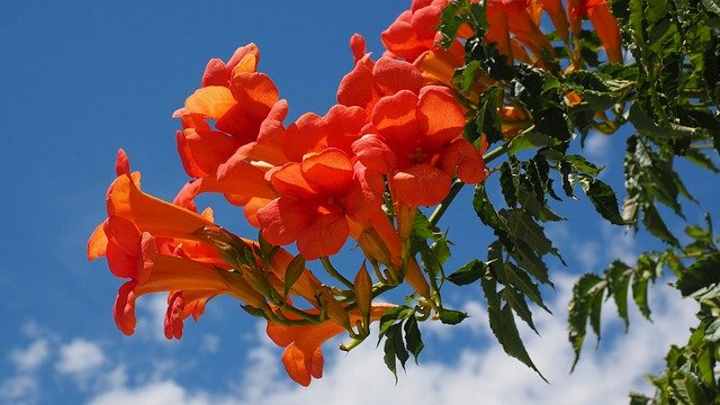
Trumpet creeper is a fast growing vine that can grow on trellises and has orange-reddish flowers
Trumpet creeper, also known as foxglove vine, is a fast-growing flowering woody climber native to Eastern Texas. This vine’s eye-catching feature is its trumpet-shaped flowers in orange and red shades. These long-blooming summer tubular flowers are followed by bean-like seed pods. Trumpet creeper’s dense foliage and vibrant flowers create a lush backdrop in subtropical gardens.
Trumpet creeper is a great addition to a garden or landscape for climbing over a trellis, fence, or arbor. You can also plant the vine as a red-flowering ground cover. However, letting it scramble up a trellis can provide shade for patio or outdoor seating areas.
However, it is important to note that trumpet creeper vines can be invasive and may require maintenance to prevent it from spreading too much.
USDA Zone: 5 to 9
Sun exposure: Full sun to partial shade
Soil type: Tolerant of various soil types but prefers well-drained soil
Height: 20 to 40 ft. (6 – 12 m)
Black-eyed Susan (Rudbeckia hirta)
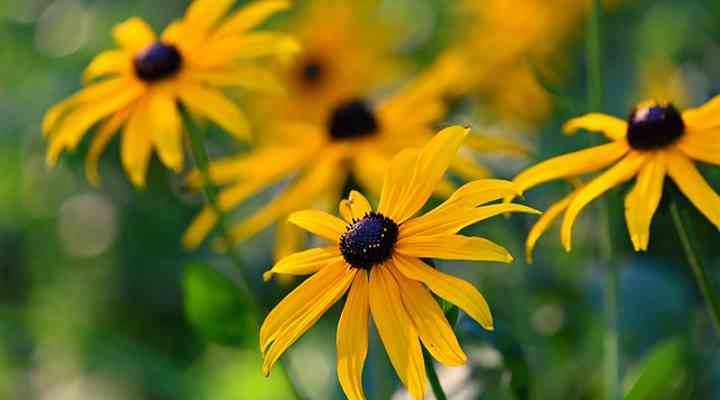
Black-eyed Susan is an easy-care drought-tolerant flowering plant that tolerates Texas summer heat
Black-eyed Susan is a Texas wildflower that blooms from summer to fall. The bright yellow ray flowers have petals surrounding a dark brown center disk, giving them a distinctive appearance. The tall yellow flowers are ideal for adding height and vibrant color in heat-stressed yards.
Black-eyed Susan’s golden yellow flowers enjoy a long blooming period. They are ideal for planting in mixed borders, meadows, wildflower gardens, and containers. The plant is low-maintenance and drought-tolerant, making it a popular choice for xeriscaping and water-wise Texas gardens.
USDA Zone: 3 to 9
Sun exposure: Full sun to partial shade
Soil type: Well-draining, fertile soil
Height: 2 to 3 ft. (0.6 – 1 m)
Purple coneflower (Echinacea purpurea)
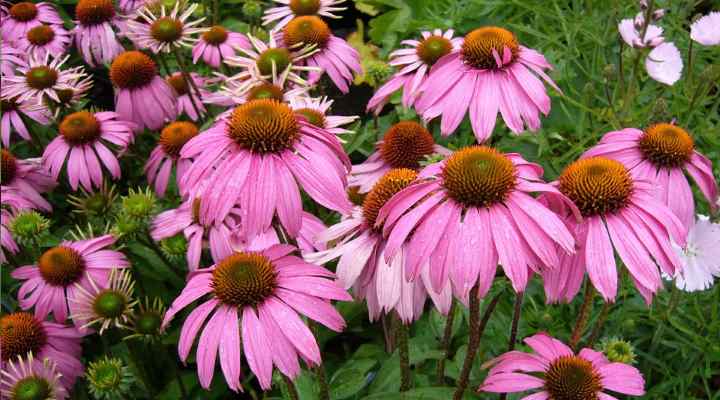
The eye-catching native Texas purple coneflower have drooping petals growing on tall stems
Purple coneflower is a flowering perennial native to the eastern and central United States. The coneflowers are stunning pink-purple daisy-like flowers with cone-shaped centers and drooping petals. The tall flowers bloom from mid-summer to early fall, making a great addition to any garden or landscape.
Purple coneflower is a low-maintenance plant, tolerant to heat, humidity, and drought—perfect for Texas flower gardens. It is ideal for planting in mixed borders, wildflower gardens, and cottage gardens.
USDA Zone: 3 to 8
Sun exposure: Full sun to partial shade
Soil type: Well-drained, fertile soil
Height: 2 to 5 ft. (0.6 – 1.5 m)
Crossvine (Bignonia capreolata)
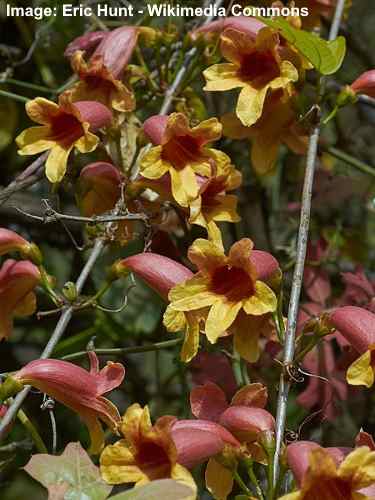
Crossvine is a fast growing Texas native vining plant with multi-colored, trumpet-shaped flowers
Native to Texas, crossvine is a woody vining plant producing yellow, red, and orange trumpet-shaped flowers. The flowers cover the vine in mid-spring and continue blooming on and off during summer. These are followed by pod-like seeds. The vine is evergreen in southern Texas, but its foliage turns reddish-purple and drops in colder climates.
Crossvine is a fast-growing plant ideal for covering walls, fences, arbors, and trellises. Its evergreen foliage makes it perfect if you want to create a privacy screen in your garden. The plant is also drought-tolerant and low-maintenance, making it a great addition to any southern garden.
USDA Zone: 6 to 9
Sun exposure: Full sun to partial shade
Soil type: Well-draining soil but can tolerate a variety of soil types
Height: 30 to 50 ft. (9 – 15 m)
Lemon Beebalm (Monarda citriodora)
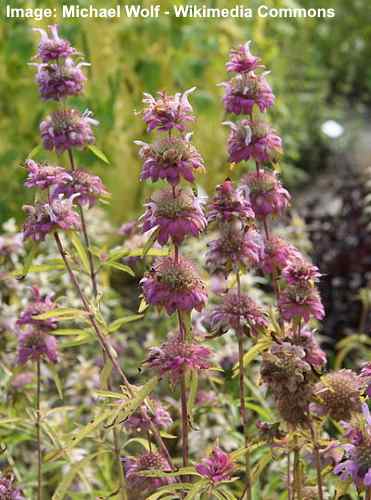
Lemon beebalm is a native flower which is well suited to the hot and dry Texas climate
Lemon beebalm is a Texas native flowering plant that makes a fragrant and colorful addition to any southern garden. Its ornamental features are spikes of lavender-pink cylindrical flower clusters with a lemony fragrance. The delicate lanceolate leaves have a lemony fragrance when crushed and can be used in salads or to make tea.
Lemon beebalm thrives in hot, sunny locations and well-drained soils. It is drought-tolerant once established and can be grown in flower borders, herb gardens, or perennial borders. Its vibrant aromatic flowers and foliage add color and texture to any garden setting.
USDA Zone: 2 to 11
Sun exposure: Full sun to partial shade
Soil type: Well-drained soils, tolerates, dry, sandy, and clay soils
Height: 1 to 3 ft. (0.3 – 1 m)
Winecup (Callirhoe involucrata)
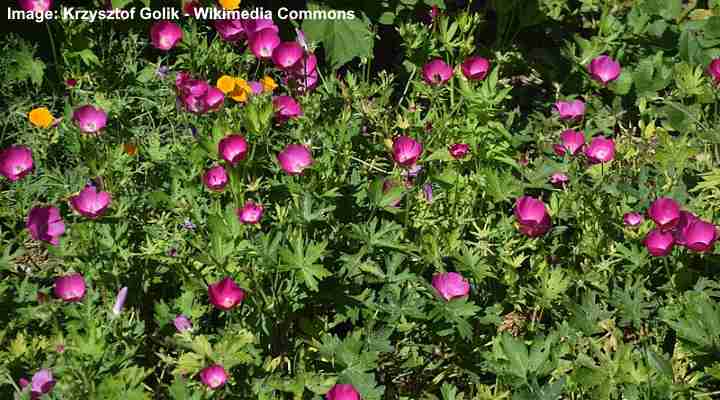
Winecup is a ground-cover flowering perennial that thrives in Texas desert landscapes
Winecup, or purple poppy mallow, is a low-growing perennial prairie plant that produces stunning, cup-shaped flowers. The pink, magenta, and purple flowers bloom from spring through summer, adding a splash of vibrant color to southern landscapes. The spreading, ground-hugging plant is ideal for rock gardens, ground cover, xeriscape, and low-water gardens.
USDA Zone: 5 to 9
Sun exposure: Full sun
Soil type: Well-drained, sandy, infertile, or dry, rocky soils
Height: 6 to 12 inches (15 – 30 cm)
Davis Mountain Mock Vervain (Glandularia bipinnatifida)
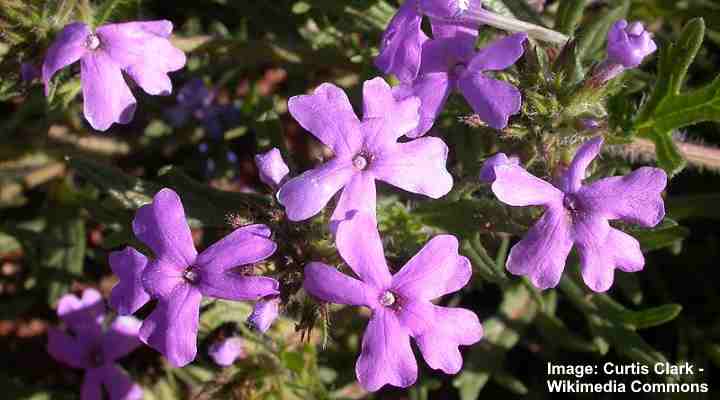
Davis mountain mock vervain is a purple flowering ground cover plant native to Texas
Also called prairie verbena, Davis mountain mock vervain is a low-growing, sprawling flowering perennial plant native to Texas. Purple verbena produces rounded clusters of delicate lavender-pink flowers that bloom from spring to fall, creating a mat of purple color in Texan gardens.
Davis Mountain mock vervain is perfect for planting in rock gardens, flower borders, and container gardens. Its ground-hugging habit makes it ideal for planting between stepping stones or along paths. Its fragrant leaves and flowers make it an excellent choice for adding beauty to your garden.
USDA Zone: 5 to 8
Sun exposure: Full sun
Soil type: Dry to medium well-drained soils, including sandy, loamy, and clay soils
Height: 6 to 12 inches (15 – 30 cm)
Golden Columbine (Aquilegia chrysantha)

The golden columbine is a yellow flowering perennial plant that is suitable for full sun or partial shade
Golden columbine is a flowering herbaceous plant native to the southwestern United States. The Texas native flower blooms in spring and summer with masses of bright yellow showy flowers. It has fern-like bushy foliage that adds texture and interest to any garden. You can plant golden columbine flowers in borders and rock gardens or allow it to cascade over a retaining wall.
USDA Zone: 3 to 8
Sun exposure: Full sun to partial shade
Soil type: Well-drained soils, including sandy, loamy, and rocky soils
Height: 2 to 3 ft. (0.6 – 1 m)
Desert Willow (Chilopsis linearis)
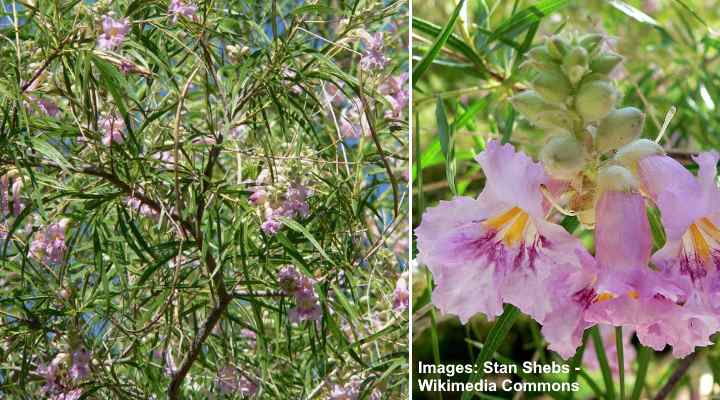
Desert willow is a small pink flowering tree native to Western Texas
Desert willow is a shrub or small tree producing beautiful trumpet-shaped flowers and willow-like leaves. The fragrant, pale violet, pink, or lavender blooms appear from spring through summer. This hardy heat and drought-tolerant shrub is ideal for planting desert gardens, xeriscapes, or as a specimen tree in a front or backyard.
USDA Zone: 7 to 11
Sun exposure: Full sun
Soil type: Well-drained soils but can tolerate a variety of soil types
Height: 15 to 30 ft. (4.5 – 9 m)
Texas Firecracker (Anisacanthus quadrifidus)
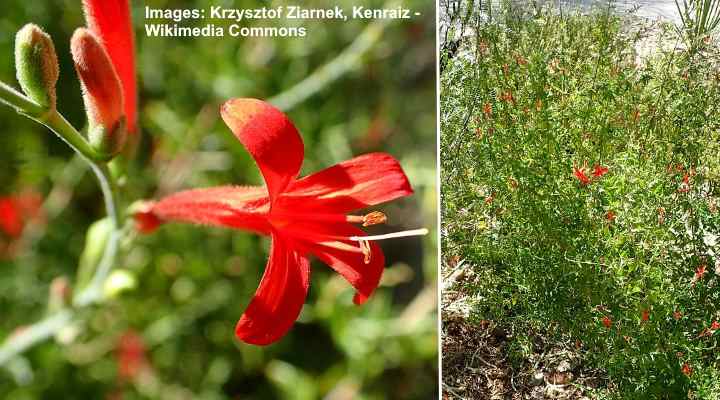
Texas firecracker is a red flowering plant for sunny and dry locations
Texas firecracker is native to the southern United States. Also called desert honeysuckle, the shrub produces striking red-orange tubular flowers that bloom in summer and fall. Its tolerance to heat, drought, and cold make it a great addition to any garden landscape in Texas. The plant’s glossy leaves and bright green color add to its ornamental value.
Texas firecracker is a great landscaping option for adding color to a garden bed or as a specimen plant. Due to its dense foliage, the plant can also be used as a hedge or privacy screen.
USDA Zone: 7 to 10
Sun exposure: Full sun
Soil type: Almost all soil types that are well-draining
Height: 3 to 5 ft. (0.9 – 1.5 m)
Yellow Bells (Tecoma stans)
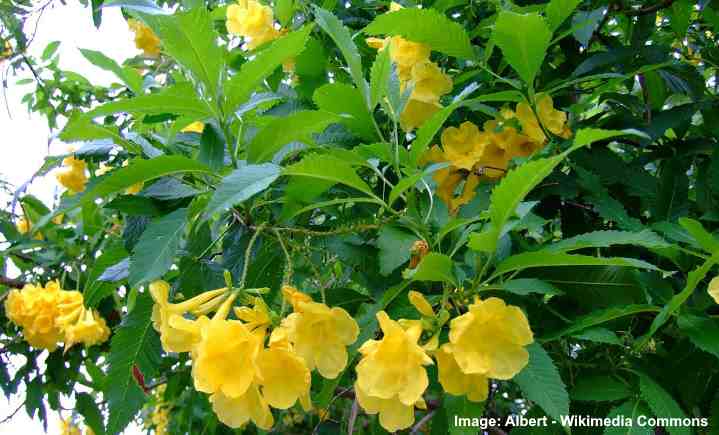
Yellow bells shrub or small tree has yellow trumpet-shaped flowers and is suitable for dry arid landscapes in Texas
Yellow bells is a fast-growing flowering shrub or small tree that is native to Texas. The heat and drought-tolerant plant blooms throughout summer with clusters of bright, yellow, trumpet-shaped flowers. These contrast nicely with bright green leaves for a splash of vibrant color in southern gardens.
Yellow bells is a versatile plant that can be grown as a shrub or trained to grow as a small tree in Central and South Texas. You can plant it as a specimen plant, hedge, or brighten a shrub border.
USDA Zone: 9 to 11
Sun exposure: Full sun to partial shade
Soil type: Well-draining soils
Height: 6 to 12 ft. (1.8 – 3.7 m) as a shrub or up to 20 ft. (6 m) as a small tree
Texas Hummingbird Mint (Agastache cana)

Texas hummingbird mint is a decorative perennial plant with purple-pink flower spikes
Texas hummingbird mint is a bushy perennial with attractive, fragrant tubular flowers growing in conical clusters. The pink, lavender, or purple flowers bloom from early summer through fall. Additionally, its aromatic leaves have a minty fragrance when crushed, and the sweet flowers attract hummingbirds.
Texas hummingbird mint thrives in hot, dry conditions. It is perfect for xeriscaping, rock gardens, and growing in borders. The fragrant flowers add color and texture to any garden. The plant’s ability to attract pollinators makes it an excellent choice for eco-friendly landscaping.
USDA Zone: 5 to 9
Sun exposure: Full sun to partial shade
Soil type: Well-drained soils
Height: 2 to 3 ft. (0.6 – 1 m)
Prickly Poppy (Argemone albiflora)
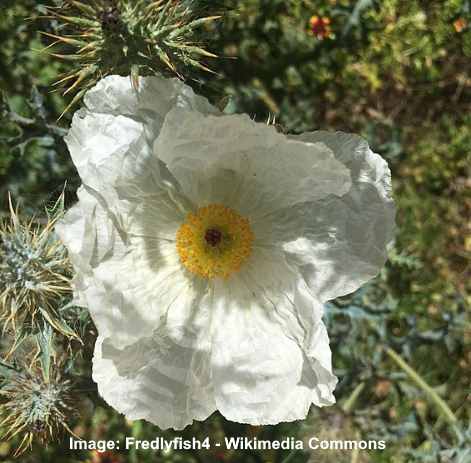
Prickly poppy is a Texas native wildflower with white flowers
Prickly poppy is a native wildflower that thrives in Texas’s hot, dry climates. The plant produces attractive cup-shaped white flowers with yellow centers, prickly stems, and thistle-like leaves. The flowers bloom in the spring and summer. Prickly poppy is ideal for xeriscaping, rock gardens, and naturalized areas. The white flowers also look stunning as cut flowers.
USDA Zone: 7 to 9
Sun exposure: Full sun or partial shade
Soil type: Well-drained, rocky, or sandy soils
Height: 2 to 3 ft. (0.6 – 1 m)
Large Flower Tickseed (Coreopsis grandiflora)
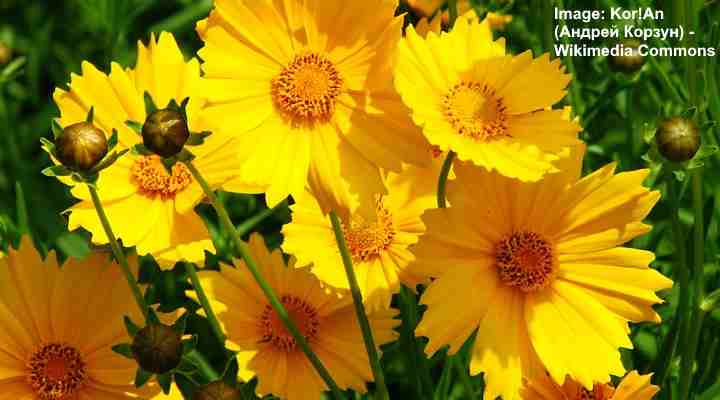
The yellow large flower tickseed adds a pop of bright color to Texas landscapes
Large flower tickseed is a Texas native yellow wildflower. The showy bright yellow flowers stretch above the mounding foliage and look stunning in breezy Texan landscapes. The blooms appear in late spring through early fall.
Large flower tickseed has compact, mounding habit – making it an ideal flower for Texas rock gardens.
USDA Zone: 4 to 9
Sun exposure: Full sun
Soil type: Dry to medium well-draining sandy or rocky soils
Height: 1 to 3 ft. (0.3 – 1 m)
Purple Prairie Clover (Dalea purpurea)

The Texas native purple prairie clover grows well in sunny locations
Purple prairie clover is a Texas native perennial plant. Its purple flowers resemble fuzzy purple cylinders on the top of wiry stems. Blooming throughout summer, the flowers add beautiful vibrant colors to Texan gardens. The plant also features attractive fern-like foliage that adds texture to any garden.
USDA Zone: 3 to 8
Sun exposure: Full sun
Soil type: Dry to moist soils as long as there is excellent drainage
Height: 1 to 3 ft. (0.3 – 1 m)
- Discover the most beautiful Texas wildflowers to grow in the garden
- Find out the best outdoor plants for Texas
